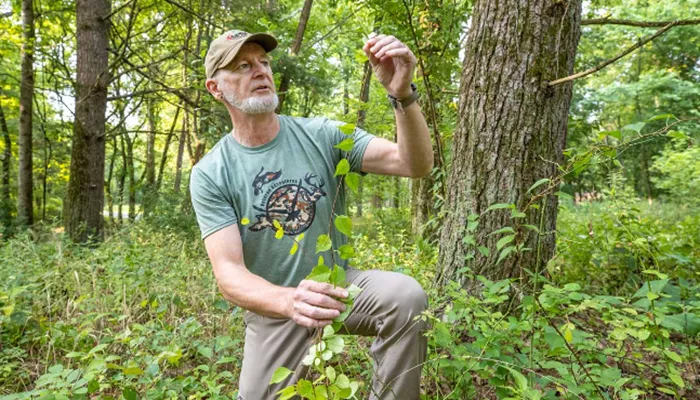CARBONDALE, Ill. – The striking beauty of bush honeysuckle and multiflora rose may catch the eye in local forests and yards, but these non-native plants are threatening native wildlife and ecosystems. In response, Southern Illinois University Carbondale (SIU) has launched an ambitious effort to restore the natural landscape at its Touch of Nature Outdoor Education Center (TON), located just south of Carbondale.
Introduced to the U.S. decades ago for purposes such as wildlife cover, erosion control, and ornamental landscaping, species like autumn olive, bush honeysuckle, and multiflora rose have spread rapidly across the region. These invasive species now dominate areas like TON, displacing native plants and the wildlife they support.
Charles Ruffner, a forestry professor at SIU, explained, “Removing invasive species allows native plants and animals to thrive in their natural environment again.”
Since 2016, Ruffner and Tom Brummer, assistant director of facilities and operations at TON, have led efforts to reclaim 150 acres of the 3,300-acre center, focusing on areas near the main camp and along the roads. While it’s just the beginning, Brummer described the results as “visually effective,” signaling a positive start to the long-term project.
Restoring the Forest
Eli Oberle, a senior forestry major from Cape Girardeau, Missouri, has been working on the restoration project for several months. His efforts include removing invasive species from both the understory and midstory of the forest, particularly autumn olive, and treating other invasive plants. Oberle explained that the land at TON was once used for agriculture and remains relatively young in terms of forest development. “The work we’re doing now will set the stage for the forest’s future health,” he said.
Oberle is part of a larger team of SIU students, staff, and volunteers working on the project. This group is tackling the restoration not just as a physical task, but as a critical lesson in forest management and conservation.
Why It Matters
The spread of invasive species has serious consequences for local wildlife, which often depend on specific plants for food and shelter. Ruffner emphasized that removing species like autumn olive and honeysuckle helps native plants like oak and hickory trees thrive, providing vital resources such as acorns and nuts for animals like deer, turkey, and bobcats.
Many animals, including hundreds of insect and animal species, rely on oak trees, which cycle through years of scarce acorn production followed by “mast years” of abundant crops. These cycles support the survival of local wildlife, but only if the ecosystem remains balanced. By removing invasive species, the team is working to restore that balance.
A Collaborative Effort
The restoration project at TON is the result of years of planning, starting with an in-depth land management plan developed by Ruffner and his team. SIU students conducted plant inventories, mapped the area with GIS tools, and studied past land management practices to understand the spread of invasive species.
The team also includes faculty members such as Eric Holzmueller, professor of forestry, and experts like Megan Alkazoff and Ashley Bergman Hays, both SIU alumni. Their collective work has informed the best practices for managing TON’s land and ensuring its long-term health.
Bergman Hays, whose research looked at past land use and forest conditions, discovered that much of the original biodiversity at TON was disturbed in the late 19th century due to heavy logging and agricultural activities. These practices led to the introduction of non-native species in the early 20th century, which further disrupted the ecosystem. Today, these plants are being removed, with the goal of returning the forest to a more natural state.
A Multi-Pronged Approach
The restoration process involves a combination of mechanical removal, herbicide treatments, and ongoing management to ensure that invasive plants do not regrow. This approach mirrors the way cancer treatment works, as Ruffner put it—removing the harmful species while allowing the native plants and trees to recover and thrive.
The current focus is on clearing invasive plants from key areas such as Camp 1, rights-of-way, and access points to Camp 2. The team is also seeking additional funding to expand the work into other parts of the park, including trails and forested areas.
Brummer noted, “We want people to see the forest in its true form, not just the trees.”
A Learning Opportunity
The restoration work is also providing valuable hands-on experience for students like Oberle, who see it as a perfect complement to their academic coursework. “You can’t run a chainsaw in a lecture hall,” Oberle said, highlighting the importance of practical experience in forestry.
In addition to providing a living classroom for students, the project aligns with the educational mission of TON, offering demonstration plots for visitors to learn about the impact of invasive species and the benefits of native plant restoration.
Future Plans and Support
The restoration project requires substantial resources, including funding, manpower, and expertise. Much of the work has been made possible through grants from the SIU Green Fund, which was established by a student-led initiative. Since 2009, this fund has supported efforts such as the forest inventory, GIS mapping, and a plant survey by Illinois botanist Chris Benda.
Despite the challenges, Ruffner and Brummer are optimistic about the future. With ongoing support from SIU students, faculty, and community volunteers, TON is poised to become a model for land restoration and forest management. As Brummer put it, “It’s a place that has been special to many, and we’re working to make sure it stays that way for generations to come.”
Related topics:
- Plant Favorites Shine Through at Louisiana State Trials Despite Challenging Conditions
- New Trees Make Breathing Easier for Neighbors in West Indy
- Don’t Let This Invasive Plant Sneak Into Your Holiday Wreaths


